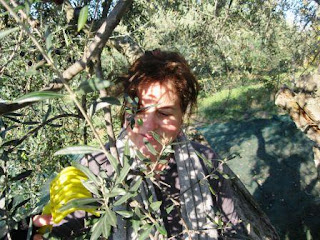On Saturday a group of friends headed to the outskirts of Viterbo for a day in the sun, picking olives. It was another glorious fall day which began with temps in the low 40's and warmed up to 60 or so in the full sun. The head of our school owns what is essentially a gentleman's farm. It is a narrow strip of land where he keeps chickens, plants a substantial garden and approximately half of which is planted in two varieties of olives. 54 trees, to be exact. Most are trees which are kept for their oil producing properties, but a few are a variety which is used for brining and eating. You can make oil from the second variety and it tastes just fine, but the yield per kilo of olives is lower.
Olive trees can live to be very old. Typically they are cut down every few hundred years and allowed to grow back from the central root stalk to keep them healthy. The trees we were working in are all around 100 years old - or at least the current round of growth is. Size-wise the trees are roughly the same as a standard apple tree. In an olive grove like the one we were working, the trees are carefully tended. They are pruned several times a year and never allowed to grow overly tall since then the olives at the top would be too difficult to harvest. The olive harvest lasts for months, beginning in early October and stretching into January. Olives do not mature at the same time on the tree. Since the object of our picking was oil, it didn't matter whether the olives were green, black or somewhere in between. We stripped the trees were were working in as bare as we possibly could. Olives do not grow on first year growth, they come in only on 2-4 year old branches
The picking process began by spreading heavy, mesh tarps on the ground to catch the olives. Next, a hand-like rake was employed to rake the olives from the branches. They sometime grow in clusters and other times can be spotted down a branch almost like leaves. Unless the olives are very ripe they like to stay stuck to the branch and you need to be quite vigorous in your attack. Ladders are leaned into the upper branches to allow for harvesting stuff higher up although care must be taken. Our fearless leader is out of commission due to a pair of broken ribs sustained when the branch he was leaning his ladder on gave way several weeks ago and he hit the ground awkwardly with the branch and ladder. For a more genteel approach, you can pick by hand rather than raking. You end up with somewhat dirty hands but the residual oil coats them and makes them soft and smooth.
After an 8 hour day which included a hearty lunch of bruschetta and pasta we had pulled in right around 300 kilos of olives from approximately 11 trees. This was actually a pretty impressive haul and just met the minimum required for pressing at the cooperative he is part of. If he is lucky, it will yield 40-45 liters of oil. Each of us will get a liter for our efforts, yielding a small return on his part for hours of tending trees over the course of the year and all the expenses incurred for pest control, pressing, bottling, etc. There must be a different way of doing this commercially, otherwise there would be no incentive to produce oil or it would cost much more than it already does.




No comments:
Post a Comment